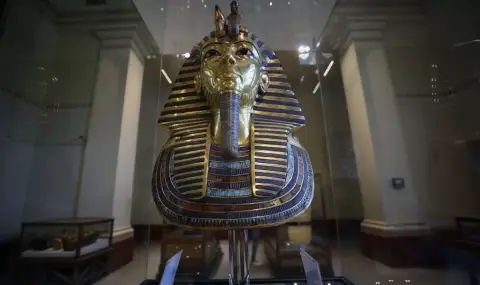On February 12, 1922, the tomb of Nebheperura Tutankhamun, an Egyptian pharaoh from the Eighteenth Pharaonic Dynasty, was discovered in the Valley of the Kings. His tomb, discovered by the English archaeologist Howard Carter, is the only intact royal burial from Ancient Egypt ever discovered.
The Cairo Museum also exhibits over 1,700 objects found in Tutankhamun's tomb.
Many others of lesser value are kept in the storerooms. Two long halls and a smaller room are filled with the numerous exhibits. Undoubtedly the most valuable artifact is the gilded funeral mask of Tutankhamun, inlaid with blue lapis lazuli.
Tutankhamun was the last heir to a powerful family that ruled Egypt for centuries. He was laid to rest in 4 gilded coffins, placed one inside the other, 3 sarcophagi, all placed in a coffin of red quartzite, notes the newspaper "Maritsa".
Tutankhamun ascended the throne at the age of 8 and died at the age of 19. According to most researchers, his death was caused by a strong blow to the back of the head. Some more recent studies point to gangrene of the left leg as a more likely cause - an infection after a broken leg, combined with complications from malaria.
Dr. Richard Boyer of the Children's Medical Center in Salt Lake City is studying X-rays of Tutankhamun's mummy, taken in 1968. Scientists have found that the body has a strange curvature of the spine and the connection in the upper part of the spine. These are symptoms similar to Klippel-Feil syndrome. The patient has plexuses of the vertebrae, i.e.
The pharaoh cannot move his head normally. When turning, such a person must twist his entire body.
The young pharaoh became perhaps the most famous ruler of Ancient Egypt after the discovery of his tomb, although he did not leave a noticeable mark on his reign. His popularity is due both to the uniqueness of the discovery and to the so-called “curse of the pharaoh“. The rumor about it spread after the death of Lord Carnarvon, who financed the expedition.
According to rumors, “death comes on swift wings to the one who dared to disturb the peace of the pharaoh“.
It all started five months after the discovery of the crypt, Lord George Herbert Carnarvon, who financed the venture, was bitten by a mosquito on the cheek, his health deteriorated and led to his death due to poisoning.
The younger brother of Earl Carnarvon – Aubrey Herbert, died of unexplained causes in 1923, after a simple tooth extraction.
In 1923, George Gold also died – Earl Carnarvon's closest friend.
The same year, the Canadian architect La Fleur, who had arrived in Egypt to help Carter, also died of a mysterious illness, dariknews.bg recalls.
In 1926, the curse also befell Bernard Pine Grenfell - a specialist in ancient manuscripts, Carnarvon's consultant in the translations of Egyptian texts.
Lord Carnarvon's private secretary - Richard Bethell, was found dead in his bed in 1929. Bethell helped Carter in the work of cataloguing the treasures of Tutankhamun, and the true cause of his death has forever remained a mystery.
